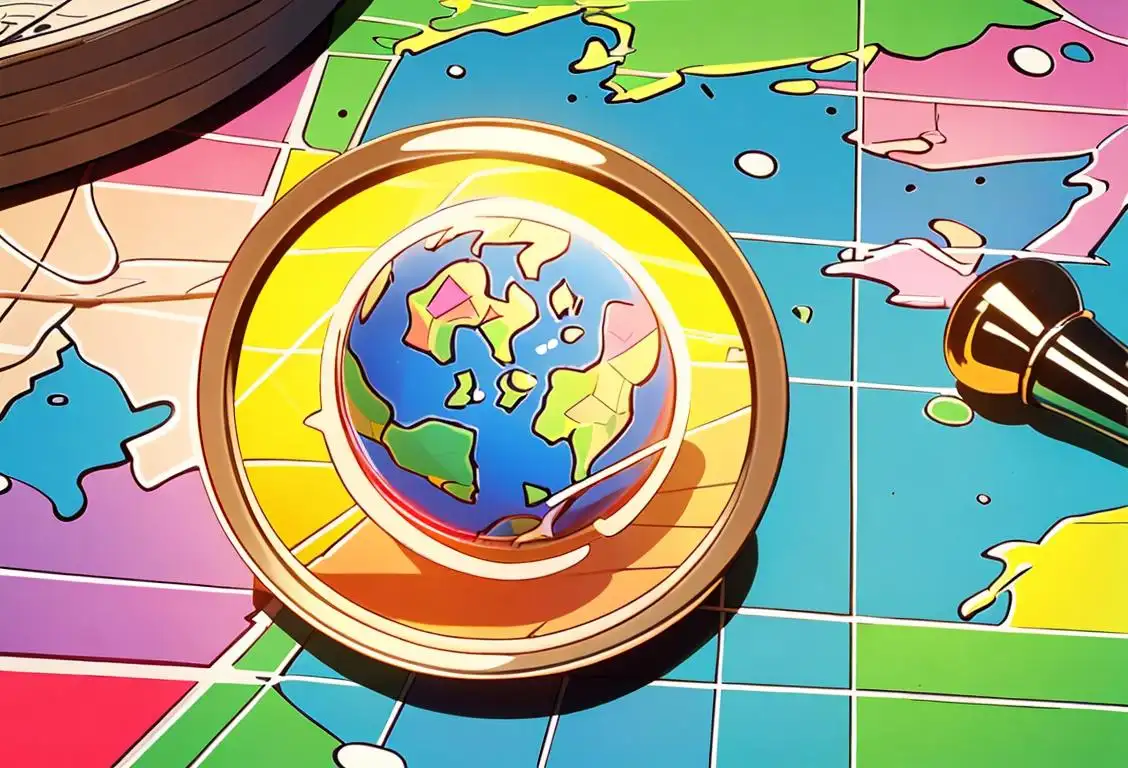National Postage Stamp Day

Ah, National Postage Stamp Day! It's that special time of year when we give a little love to those tiny pieces of paper that make our mail go 'round. So pull out your stamp collection and get ready to celebrate! Here's everything you need to know about this fascinating day.
When is Postage Stamp Day?
It's national postage stamp day on the 1st July.
The Origins of National Postage Stamp Day
National Postage Stamp Day may not be the most well-known holiday on the calendar, but it sure is a stamp collector's dream come true! This delightful day is a celebration of all things postage stamp related and provides an opportunity for philatelists to share their passion with the world.
The exact origins of this quirky holiday are a bit mysterious, much like an undeliverable letter. However, it is believed to have started back in the days when snail mail ruled the world. Some speculate that it began as a way to honor the invention of the first adhesive postage stamp, the Penny Black, back in 1840. Others say it was simply born out of the sheer joy of receiving a beautifully adorned envelope in the mail.
No matter its origins, National Postage Stamp Day has gained popularity over the years, with stamp collectors and enthusiasts eagerly awaiting its arrival each July.
How to Celebrate
Now that you know the history behind National Postage Stamp Day, it's time to dive into the fun ways you can celebrate. Here are a few ideas to get you started:
- Host a Stamp Swap: Gather your fellow philatelists and organize a stamp trading event. It's a great way to expand your collection and make new friends who share your passion.
- Create Postage Stamp Art: Get creative and use postage stamps as the medium for your next art project. Design collages, mosaics, or even jewelry using colorful stamps.
- Visit a Postal Museum: If you're lucky enough to have a postal museum nearby, take a trip and immerse yourself in the rich history of stamps and mail delivery.
- Send a Special Letter: Choose a unique postage stamp and send a handwritten letter to a loved one. They'll appreciate the extra effort and the beautiful stamp.
Did You Know?
Did you know that the rarest postage stamp in the world is the British Guiana 1c Magenta? Only one specimen of this stamp exists, making it the Holy Grail for stamp collectors. In 2014, it was sold at auction for a staggering $9.5 million. Talk about a priceless piece of paper!
History behind the term 'Postage Stamp'
1840
Introduction of the Penny Black
In 1840, the British introduced the Penny Black, the world's first adhesive postage stamp. Designed by Sir Rowland Hill, the Penny Black featured a profile of Queen Victoria and had a uniform price of one penny, regardless of the distance. This revolutionary idea of using a small piece of paper to indicate prepayment of postage fees quickly gained popularity.
1840
The Birth of Prepaid Postal System
In 1840, the world's first prepaid postal system, the Penny Black, was introduced in the United Kingdom. The Penny Black revolutionized the postage system by doing away with the need for the recipient to pay for the delivery, shifting the responsibility to the sender instead. The use of prepaid postage was a significant step forward in making the postal system more efficient and accessible.
1837
Invention of the adhesive postage stamp
In 1837, the British Civil Servant Sir Rowland Hill revolutionized the postal system by introducing the concept of postage stamps. He proposed the idea of a small, adhesive label that could be affixed to mail in order to indicate that postage had been paid. This innovative approach aimed to simplify the process of sending mail and eliminate the need for individual letters to be weighed and assessed for postage.
1840
Introduction of the Penny Black
In 1840, the United Kingdom introduced the world's first postage stamp, known as the Penny Black. This small adhesive label featured the profile of Queen Victoria and was used to prepay postage. The Penny Black revolutionized the postal system by simplifying the process of sending mail. Prior to its introduction, recipients typically paid the postage upon delivery, which often led to confusion and disputes. The Penny Black set the standard for future postage stamps and quickly gained wide popularity.
1840
The Birth of the Penny Black
In 1840, the world's first official adhesive postage stamp was introduced in Britain. Known as the Penny Black, it featured the profile of Queen Victoria and had a denomination of one penny. This revolutionary innovation allowed the sender to prepay postage on mail, eliminating the need for the recipient to pay upon delivery. The Penny Black was a landmark in the history of mail and gave birth to the term 'postage stamp'.
1840
Introduction of the Penny Black
In 1840, the term 'postage stamp' was first associated with the introduction of the Penny Black, the world's first adhesive postage stamp. The Penny Black, designed by Sir Rowland Hill, was issued in the United Kingdom. This stamp featured a profile of Queen Victoria and was used to prepay the postage on letters and packages.
1847
The First U.S. Postage Stamps
In 1847, the United States issued its first postage stamps, the 5-cent Benjamin Franklin stamp, and the 10-cent George Washington stamp. These stamps, known as the '1847 Issue,' marked the official introduction of postage stamps in the United States. Prior to this, postal services in the U.S. primarily relied on letters and packages being privately marked with the postage value.
1841
Perforated Stamps for Easier Separation
In 1841, the second iteration of postage stamps known as the Penny Red appeared. It replaced the Penny Black and introduced a new feature: perforations. Perforated stamps had small holes around their edges, which made it easier for users to separate them from each other. This clever innovation improved the handling of stamps and set the stage for the development of more efficient postal systems around the world.
1847
The First U.S. Postage Stamps
In 1847, the United States issued its first postage stamps, commonly known as the '1847 Issue.' These stamps featured portraits of Benjamin Franklin and George Washington. The introduction of postage stamps in the U.S. marked a significant milestone in the history of the term 'postage stamp', as it became widely accepted and adopted by other countries around the world.
1840
First official postage stamp: Penny Black
The year 1840 marked a significant milestone in the history of postage stamps with the introduction of the first-ever official postage stamp, the Penny Black, in the United Kingdom. The Penny Black featured a portrait of Queen Victoria and was printed in black ink on a small, rectangular piece of paper. It was the first mass-produced stamp and had a face value of one penny.
1843
Perforated Stamps
In 1843, the concept of perforated stamps was introduced. Prior to this innovation, the Penny Black and subsequent stamps were not easy to separate from one another. Collectors and postal workers had to use scissors or knives to cut the stamps out individually. The introduction of perforations allowed for the stamps to be easily detached from a sheet, making the process more efficient. This development not only reduced the effort required to handle stamps but also paved the way for advancements in stamp production and distribution.
1847
First Postal Stamps in the United States
In 1847, the United States issued its first postage stamps, known as the '1847 Issue'. Two denominations were released, a 5-cent stamp featuring Benjamin Franklin and a 10-cent stamp depicting George Washington. These stamps were printed on a rather delicate thin paper and featured intricate engravings, making them highly valuable among collectors today.
1851
Perforated Stamps for Easy Separation
In 1851, the first perforated stamps, which featured small holes along the edges, were introduced in Great Britain. The inclusion of perforations allowed for easier separation of stamps from a sheet, eliminating the need for scissors to separate individual stamps. This innovation greatly improved the convenience and speed of preparing mail for delivery.
1851
Perforated postage stamps
The year 1851 witnessed another important development in postage stamp history with the introduction of perforated stamps. Prior to this innovation, stamps were either cut individually or torn from sheets, which often led to damage or forgery. Perforated stamps featured small holes along the edges, allowing for easier separation and ensuring the authenticity of the stamp.
1864
The Invention of Adhesive Backing
In 1864, an adhesive backing was introduced for postage stamps. Prior to this innovation, stamps had to be affixed to mail using glue or paste. This new backing made it much easier for individuals to adhere stamps to envelopes, eliminating the need for additional adhesive substances. The introduction of adhesive backing further streamlined the mailing process and made it more convenient for both senders and recipients.
1851
Perforated Stamps
In 1851, the UK introduced perforated stamps, which made separation easier. Prior to this innovation, stamps had to be individually cut using scissors or blades. The introduction of perforations allowed for quicker and more efficient separation, simplifying the process of using stamps.
1855
Perforated Stamps for Easy Separation
In 1855, the first perforated stamps were introduced, making it easier for people to separate individual stamps without using scissors or a knife. This innovation greatly improved the convenience of using postage stamps and became a standard feature in subsequent stamp designs.
1847
Postage Stamps Reach the United States
In 1847, the United States issued its first postage stamps. The first stamps also featured the profiles of historical figures, Benjamin Franklin and George Washington. The intriguing aspect of these early U.S. stamps was that they were imperforate, meaning they had to be individually cut with scissors or a knife. However, this was only a temporary inconvenience, as the U.S. quickly adopted the practice of perforation to facilitate separation, just like its British counterparts.
1864
The Birth of Commemorative Stamps
In 1864, the first commemorative postage stamp was issued by the United States. The stamp, known as the 'Black Jack,' was released to commemorate the 1863 issue of a 2-cent black Andrew Jackson stamp. Commemorative stamps, which depict special events, anniversaries, or noteworthy individuals, have since become a popular and collectible aspect of the postage stamp hobby.
1864
First postally-used adhesive postage stamps
While adhesive postage stamps were created in 1837, it wasn't until 1864 when the first postally-used adhesive postage stamps were issued. Prior to this, postage stamps were commonly canceled by postal clerks using pen or hand-stamps. The introduction of postally-used adhesive stamps marked a significant advancement in the efficiency of the postal system by providing a standardized method of marking prepaid mail.
1864
The Birth of Adhesive Postage Stamps
In 1864, the adhesive postage stamp, which featured a layer of glue on the back, was introduced in the United States. These stamps, also known as 'lick-and-stick' stamps, revolutionized the way postage was applied to letters and packages. Instead of using wax or other methods of attachment, individuals could simply moisten the stamp and affix it to the envelope or parcel. The adhesive postage stamp quickly became the standard for postal services worldwide.
1862
The Advent of Cancellations
In 1862, a significant development occurred in the history of postage stamps: the introduction of cancellations. Cancellations were applied by postal authorities to mark stamps that had already been used, preventing their reuse. The early cancellations took various forms, from pen strokes to intricate designs, and later evolved into more standardized and efficient methods. Cancellations not only ensured that stamps were used only once but also added a distinct aesthetic element to the stamps themselves.
1890
Introduction of Commemorative Stamps
In 1890, the United States introduced the first commemorative stamp, known as the 'Columbian Issue.' These stamps were issued to celebrate the 400th anniversary of Christopher Columbus' voyage to the Americas. Unlike regular postage stamps, commemorative stamps are released for a limited time and often feature special designs or themes. The introduction of commemorative stamps added a new dimension to stamp collecting, as enthusiasts began seeking out these unique and visually appealing designs.
1864
Introduction of the Uniform Penny Post
In 1864, the United Kingdom introduced the Uniform Penny Post, a system where a postage stamp would allow the sender to mail a letter weighing up to half an ounce anywhere within the country. This system further popularized the use of postage stamps and facilitated broader communication among people.
1890
The Introduction of Commemorative Stamps
In 1890, the world's first commemorative stamps were issued by the United States to mark the centennial of the discovery of America by Christopher Columbus. These stamps featured a unique design in addition to the traditional postage value, commemorating a special event or honoring a specific person. Commemorative stamps soon became highly collectible and expanded the artistic and historical aspects of stamp collecting.
1927
Air Mail Stamps
In 1927, the first official air mail stamps were introduced in various countries. As aviation technology advanced and air mail services became more prevalent, specialized stamps were created specifically for sending mail via airplanes. These stamps often featured airplanes or other symbols related to air travel, highlighting the excitement and novelty of this method of communication. Air mail stamps became highly collectible, attracting both philatelists and aviation enthusiasts.
1895
Colorful Stamps Enter the Scene
By 1895, postage stamps had come a long way. The use of color was introduced, transforming stamps into miniature works of art. Various countries started to issue stamps with vibrant designs and intricate color combinations. Collecting stamps became a popular hobby, known as philately, and the beauty of stamps became appreciated worldwide. The colorful stamps captured the imagination of people and further solidified the term 'postage stamp' in popular language and culture.
1890
Introduction of picture postage stamps
In the year 1890, picture postage stamps were introduced, adding an artistic and visually appealing aspect to the world of postage. These stamps featured colorful and detailed designs, often depicting significant events, famous personalities, or landmarks. Picture postage stamps quickly gained popularity among collectors and became a medium for promoting national pride and cultural heritage.
1890
The First Commemorative Stamp
In 1890, the United States released the first-ever commemorative stamp, the 'Commodore Perry' stamp. This stamp was issued to commemorate the centennial anniversary of Oliver Hazard Perry's victory at the Battle of Lake Erie. Commemorative stamps became a way to honor special events, achievements, and famous personalities, adding diversity to stamp designs.
1928
Air Mail Stamps Take Flight
In 1928, the term 'postage stamp' expanded to include a new type of stamp designed specifically for air mail. The United States introduced its first Air Mail stamp, featuring an image of the plane called the 'Jenny.' Air Mail stamps revolutionized the international mail service, enabling faster and more efficient delivery of mail across long distances.
1922
Perforations on All Sides of the Stamp
By 1922, most countries transitioned to using stamps with perforations on all sides. Previously, stamps had perforations only on two sides, requiring people to be cautious while affixing the stamp to an envelope. This change ensured more flexibility and ease of use for both senders and postal workers.
1960s
Self-Adhesive Stamps
In the 1960s, self-adhesive stamps were developed, eliminating the need for licking or moistening the back of stamps. This innovation made stamp usage much more convenient, as individuals could simply peel off the backing and stick the stamp on the envelope. Self-adhesive stamps also reduced the risk of stamps being damaged by excess moisture. This advancement in stamp technology further improved the overall mailing experience and transformed the way people interacted with postage stamps.
1969
Self-Adhesive Stamps Enter the Scene
In 1969, the United States Postal Service introduced self-adhesive stamps, eliminating the need for licking or using a sponge to moisten the back of stamps. Self-adhesive stamps provided a more convenient and hygienic option for affixing postage to envelopes and packages. This innovation quickly gained popularity and has since become the standard for most modern postage stamps worldwide.
1960s
Self-Adhesive Stamps
In the 1960s, self-adhesive stamps were introduced, eliminating the need for licking stamps or using moistening devices. These stamps featured an adhesive backing, allowing them to be easily attached to envelopes. Self-adhesive stamps offered convenience and improved hygiene compared to traditional water-activated stamps.
2000
Digital Stamps
In the digital age, electronic or digital stamps emerged as a form of postage. Digital stamps are purchased online and printed by the sender on regular paper. These stamps have unique codes that verify their authenticity. This modern development allows for quicker and more convenient postage purchase and usage.
Did you know?
Did you know that the rarest postage stamp in the world is the British Guiana 1c Magenta? Only one specimen of this stamp exists, making it the Holy Grail for stamp collectors. In 2014, it was sold at auction for a staggering $9.5 million. Talk about a priceless piece of paper!Tagged
fun loved ones financeFirst identified
1st July 2015Most mentioned on
1st July 2015Total mentions
49Other days
Awareness Day
One Day
Action Day
Opposite Day
Seniors Day
Veterans Day
Happiness Day
Bison Day
Suicide Prevention Month Day
Family Day









